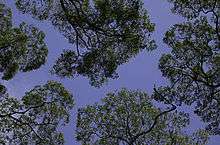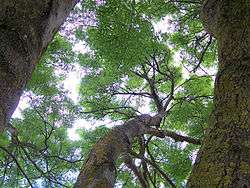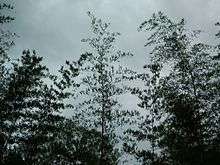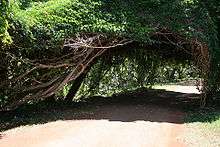Canopy (biology)
In biology, the canopy is the aboveground portion of a plant community or crop, formed by the collection of individual plant crowns.[1][2][3]




In forest ecology, canopy also refers to the upper layer or habitat zone, formed by mature tree crowns and including other biological organisms (epiphytes, lianas, arboreal animals, etc.).[4]
Sometimes the term canopy is used to refer to the extent of the outer layer of leaves of an individual tree or group of trees. Shade trees normally have a dense canopy that blocks light from lower growing plants.
Observation
Early observations of canopies were made from the ground using binoculars or by examining fallen material. Researchers would sometimes erroneously rely on extrapolation by using more reachable samples taken from the understory. In some cases, they would use unconventional methods such as chairs suspended on vines or hot-air dirigibles, among others. Modern technology, including adapted mountaineering gear, has made canopy observation significantly easier and more accurate, allowed for longer and more collaborative work, and broadened the scope of canopy study.[5]
Canopy structure

Canopy structure is the organization or spatial arrangement (three-dimensional geometry) of a plant canopy. Leaf area index (LAI), leaf area per unit ground area, is a key measure used to understand and compare plant canopies. It is also taller than the understory layer. The canopy holds 90% of the animals in the rainforest. They cover vast distances and appear to be unbroken when observed from an airplane. However, despite overlapping tree branches, rainforest canopy trees rarely touch each other. Rather, they are usually separated by a few feet.[6]
Canopy layer of forests
Dominant and co-dominant canopy trees form the uneven canopy layer. Canopy trees are able to photosynthesize relatively rapidly due to abundant light, so it supports the majority of primary productivity in forests. The canopy layer provides protection from strong winds and storms, while also intercepting sunlight and precipitation, leading to a relatively sparsely vegetated understory layer.
Forest canopies are home to unique flora and fauna not found in other layers of forests. The highest terrestrial biodiversity resides in the canopy of tropical rainforests.[7] Many rainforest animals have evolved to live solely in the canopy, and never touch the ground.
The canopy of a rainforest is typically about 10m thick, and intercepts around 95% of sunlight.[8] The canopy is below the emergent layer, a sparse layer of very tall trees, typically one or two per hectare. With an abundance of water and a near ideal temperature in rainforests, light and nutrients are two factors that limit tree growth from the understory to the canopy.
In the permaculture and forest gardening community, the canopy is the highest of seven layers.
See also
References
- Campbell, G.S.; Norman, J.M. (1989). "The description and measurement of plant canopy structure". In Russell, Graham; Marshall, Bruce; Jarvis, Paul G. (eds.). Plant Canopies: Their Growth, Form and Function. Cambridge University Press. pp. 1–19. doi:10.1017/CBO9780511752308.002. ISBN 978-0-521-39563-2. LCCN 87032902.
- Moffett, Mark W. (December 2000). "What's "Up"? A Critical Look at the Basic Terms of Canopy Biology". Biotropica. 32 (4): 569–596. doi:10.1646/0006-3606(2000)032[0569:WSUACL]2.0.CO;2.
- Hay, Robert K.M.; Porter, John R. (2006). The Physiology of Crop Yield (Second ed.). Blackwell Publishing. ISBN 978-1-4051-0859-1. LCCN 2006005216.
- Parker, Geoffrey G. (1995). "Structure and microclimate of forest canopies". In Lowman, Margaret D.; Nadkarni, Nalini M. (eds.). Forest Canopies (First ed.). Academic Press. pp. 73–106. ISBN 978-0124576506. LCCN 94041251.
- Lowman, Margaret D.; Wittman, Philip K. (1996). "Forest Canopies: Methods, Hypotheses, and Future Directions" (PDF). Annual Review of Ecology, Evolution, and Systematics. 27: 55–81. doi:10.1146/annurev.ecolsys.27.1.55. JSTOR 2097229. Archived (PDF) from the original on 7 February 2019.
- Butler, Rhett (30 July 2012). "The Rainforest Canopy". Mongabay. Archived from the original on 5 May 2020.
- Lowman, Margaret D.; Moffett, Mark (March 1993). "The ecology of tropical rain forest canopies" (PDF). Trends in Ecology & Evolution. 8 (3): 104–107. doi:10.1016/0169-5347(93)90061-S. Archived (PDF) from the original on 2 February 2020.
- "Light in the Rain Forest". garden.org. Archived from the original on 23 November 2015. Retrieved 23 November 2015.
Further reading
- Lowman, Margaret D.; Nadkarni, Nalini M., eds. (1995). Forest Canopies (First ed.). Academic Press. ISBN 978-0124576506. LCCN 94041251.
- Moffett, Mark W. (1994). The High Frontier: Exploring the Tropical Rainforest Canopy. Harvard University Press. ISBN 978-0674390386. LCCN 93016935.
- Russell, Graham; Marshall, Bruce; Jarvis, Paul G., eds. (1989). Plant Canopies: Their Growth, Form and Function. Cambridge University Press. doi:10.1017/CBO9780511752308.002. ISBN 978-0-521-39563-2. LCCN 87032902.
- Jucker, Tommaso; et al. (23 September 2018). "Canopy structure and topography jointly constrain the microclimate of human‐modified tropical landscapes". Global Change Biology. 24 (11): 5243–5258. doi:10.1111/gcb.14415.
External links
| Wikimedia Commons has media related to Tree canopies. |